Information Technology Report: Technologies, Ethics, Networks
VerifiedAdded on 2023/01/05
|11
|3118
|22
Report
AI Summary
This report offers a comprehensive introduction to Information Technology, examining various computing technologies, including cloud-based systems and their advantages and challenges. It delves into ethical and social issues associated with technology, such as personal privacy, trade secrets, fake news, and government database pressure, using Tesco as a case study. The report further explores different types of networks (LAN, WAN, MAN), the growth of Information and Communication Technology (ITC), the impact of the internet on businesses through e-commerce and other applications. It also analyzes the role of IT in management, covering inventory management, data management, customer relationship management, and management information systems. Finally, the report outlines the different stages of system development, from planning to software development.
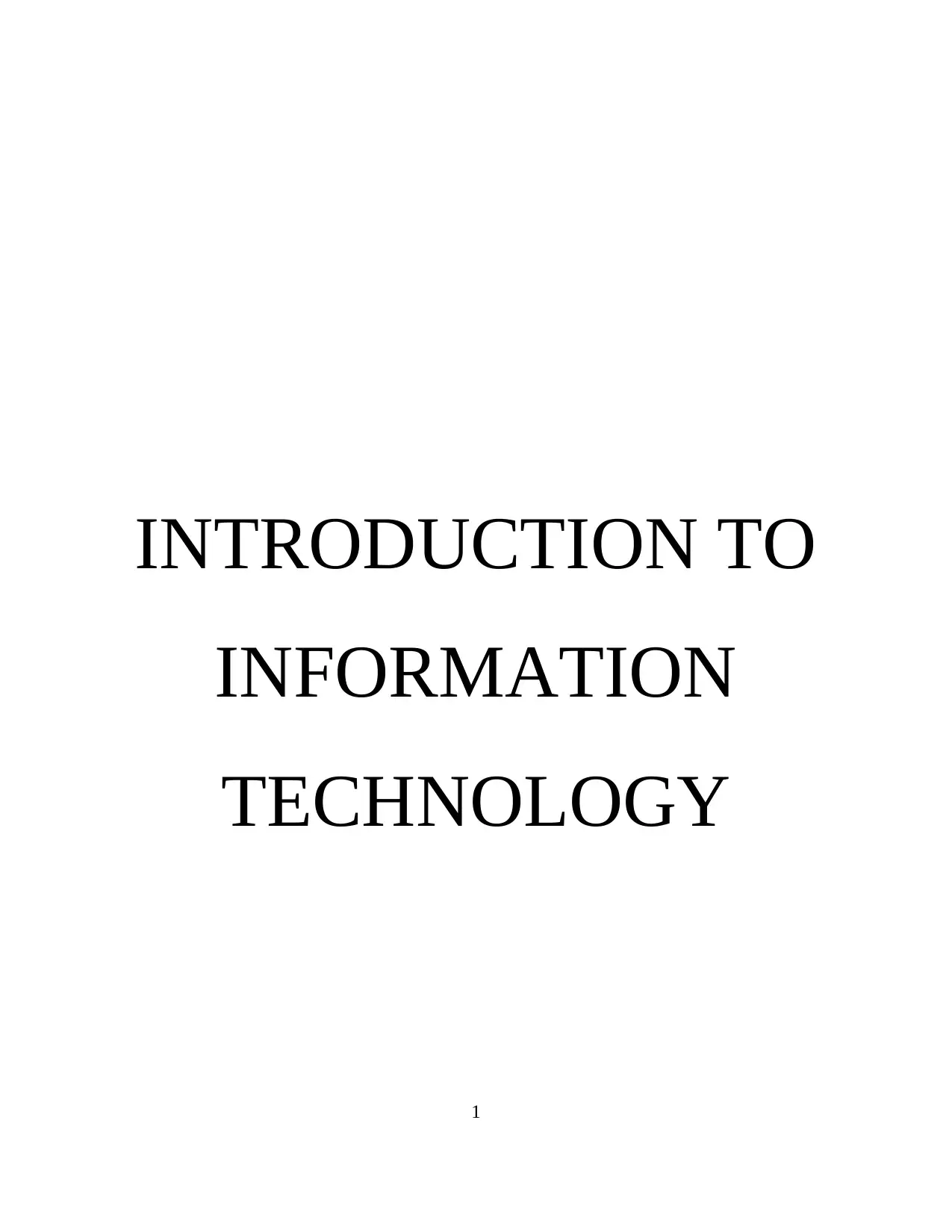
INTRODUCTION TO
INFORMATION
TECHNOLOGY
1
INFORMATION
TECHNOLOGY
1
Paraphrase This Document
Need a fresh take? Get an instant paraphrase of this document with our AI Paraphraser
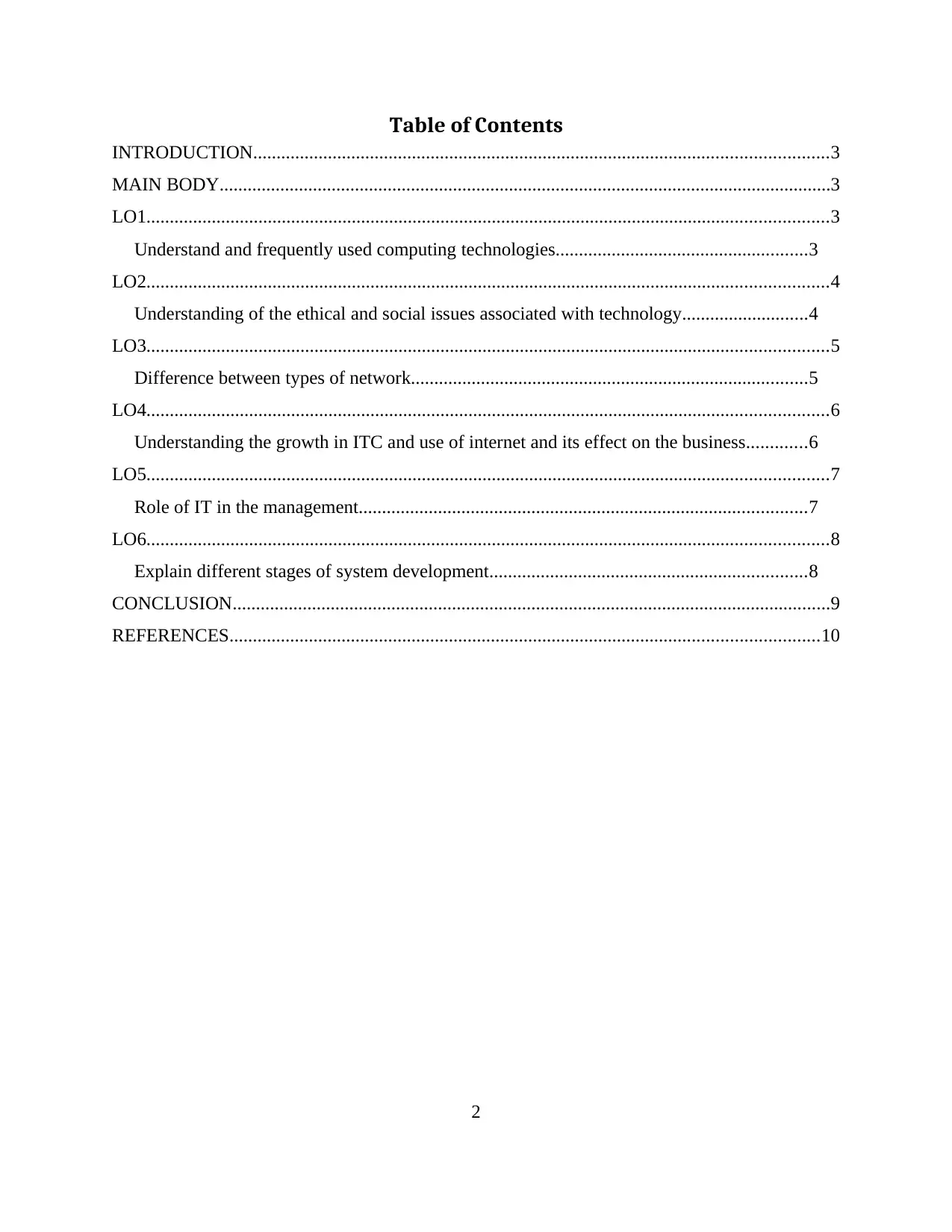
Table of Contents
INTRODUCTION...........................................................................................................................3
MAIN BODY...................................................................................................................................3
LO1..................................................................................................................................................3
Understand and frequently used computing technologies......................................................3
LO2..................................................................................................................................................4
Understanding of the ethical and social issues associated with technology...........................4
LO3..................................................................................................................................................5
Difference between types of network.....................................................................................5
LO4..................................................................................................................................................6
Understanding the growth in ITC and use of internet and its effect on the business.............6
LO5..................................................................................................................................................7
Role of IT in the management................................................................................................7
LO6..................................................................................................................................................8
Explain different stages of system development....................................................................8
CONCLUSION................................................................................................................................9
REFERENCES..............................................................................................................................10
2
INTRODUCTION...........................................................................................................................3
MAIN BODY...................................................................................................................................3
LO1..................................................................................................................................................3
Understand and frequently used computing technologies......................................................3
LO2..................................................................................................................................................4
Understanding of the ethical and social issues associated with technology...........................4
LO3..................................................................................................................................................5
Difference between types of network.....................................................................................5
LO4..................................................................................................................................................6
Understanding the growth in ITC and use of internet and its effect on the business.............6
LO5..................................................................................................................................................7
Role of IT in the management................................................................................................7
LO6..................................................................................................................................................8
Explain different stages of system development....................................................................8
CONCLUSION................................................................................................................................9
REFERENCES..............................................................................................................................10
2
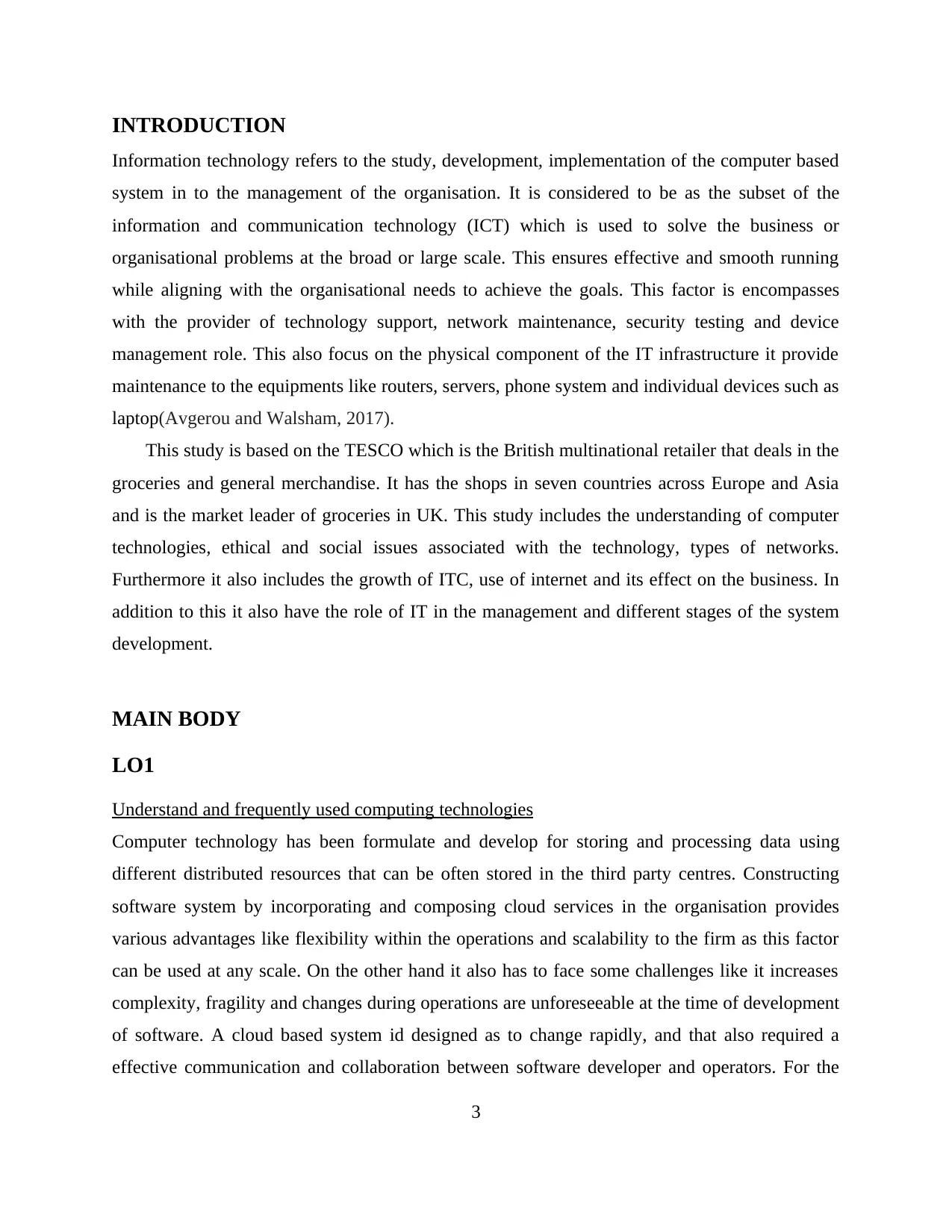
INTRODUCTION
Information technology refers to the study, development, implementation of the computer based
system in to the management of the organisation. It is considered to be as the subset of the
information and communication technology (ICT) which is used to solve the business or
organisational problems at the broad or large scale. This ensures effective and smooth running
while aligning with the organisational needs to achieve the goals. This factor is encompasses
with the provider of technology support, network maintenance, security testing and device
management role. This also focus on the physical component of the IT infrastructure it provide
maintenance to the equipments like routers, servers, phone system and individual devices such as
laptop(Avgerou and Walsham, 2017).
This study is based on the TESCO which is the British multinational retailer that deals in the
groceries and general merchandise. It has the shops in seven countries across Europe and Asia
and is the market leader of groceries in UK. This study includes the understanding of computer
technologies, ethical and social issues associated with the technology, types of networks.
Furthermore it also includes the growth of ITC, use of internet and its effect on the business. In
addition to this it also have the role of IT in the management and different stages of the system
development.
MAIN BODY
LO1
Understand and frequently used computing technologies
Computer technology has been formulate and develop for storing and processing data using
different distributed resources that can be often stored in the third party centres. Constructing
software system by incorporating and composing cloud services in the organisation provides
various advantages like flexibility within the operations and scalability to the firm as this factor
can be used at any scale. On the other hand it also has to face some challenges like it increases
complexity, fragility and changes during operations are unforeseeable at the time of development
of software. A cloud based system id designed as to change rapidly, and that also required a
effective communication and collaboration between software developer and operators. For the
3
Information technology refers to the study, development, implementation of the computer based
system in to the management of the organisation. It is considered to be as the subset of the
information and communication technology (ICT) which is used to solve the business or
organisational problems at the broad or large scale. This ensures effective and smooth running
while aligning with the organisational needs to achieve the goals. This factor is encompasses
with the provider of technology support, network maintenance, security testing and device
management role. This also focus on the physical component of the IT infrastructure it provide
maintenance to the equipments like routers, servers, phone system and individual devices such as
laptop(Avgerou and Walsham, 2017).
This study is based on the TESCO which is the British multinational retailer that deals in the
groceries and general merchandise. It has the shops in seven countries across Europe and Asia
and is the market leader of groceries in UK. This study includes the understanding of computer
technologies, ethical and social issues associated with the technology, types of networks.
Furthermore it also includes the growth of ITC, use of internet and its effect on the business. In
addition to this it also have the role of IT in the management and different stages of the system
development.
MAIN BODY
LO1
Understand and frequently used computing technologies
Computer technology has been formulate and develop for storing and processing data using
different distributed resources that can be often stored in the third party centres. Constructing
software system by incorporating and composing cloud services in the organisation provides
various advantages like flexibility within the operations and scalability to the firm as this factor
can be used at any scale. On the other hand it also has to face some challenges like it increases
complexity, fragility and changes during operations are unforeseeable at the time of development
of software. A cloud based system id designed as to change rapidly, and that also required a
effective communication and collaboration between software developer and operators. For the
3
⊘ This is a preview!⊘
Do you want full access?
Subscribe today to unlock all pages.

Trusted by 1+ million students worldwide
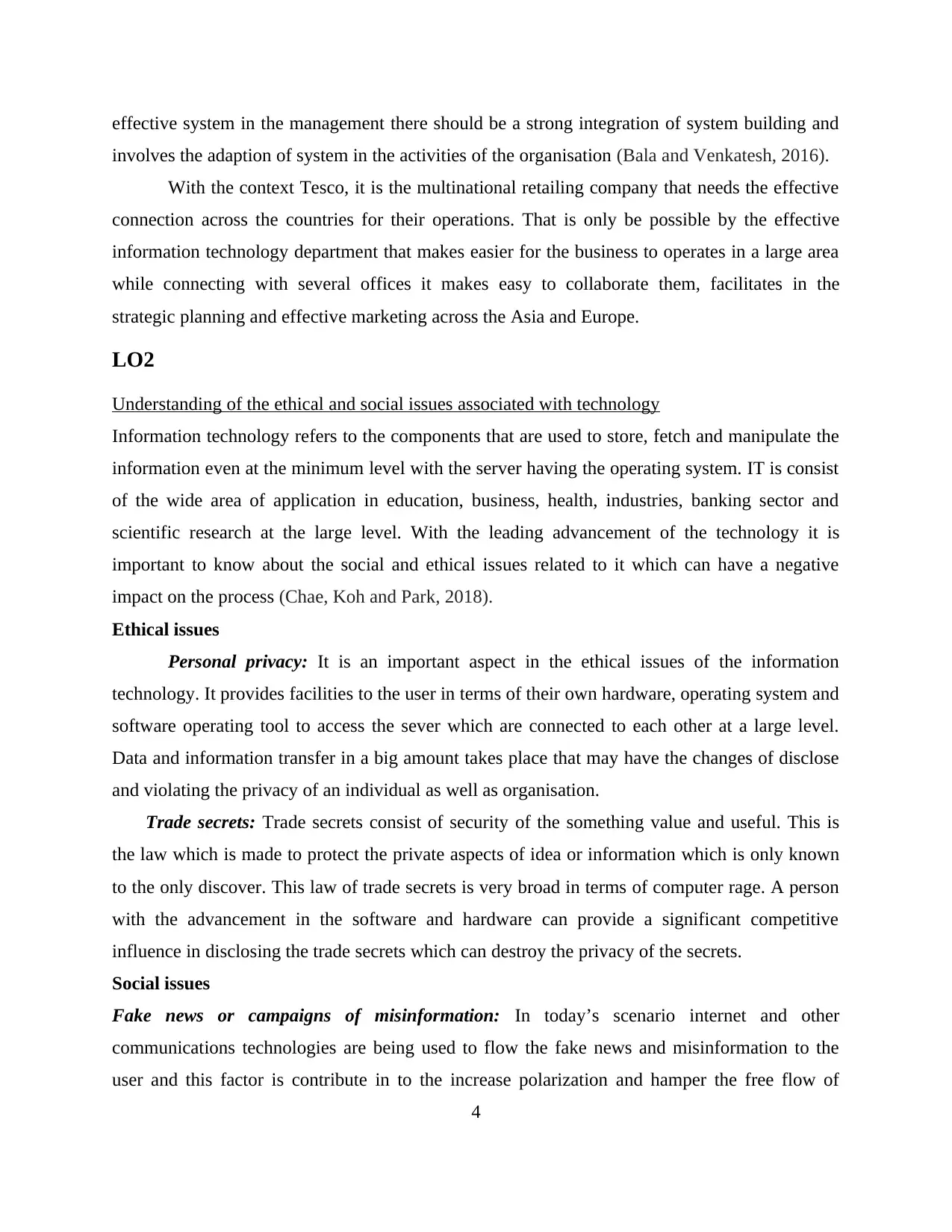
effective system in the management there should be a strong integration of system building and
involves the adaption of system in the activities of the organisation (Bala and Venkatesh, 2016).
With the context Tesco, it is the multinational retailing company that needs the effective
connection across the countries for their operations. That is only be possible by the effective
information technology department that makes easier for the business to operates in a large area
while connecting with several offices it makes easy to collaborate them, facilitates in the
strategic planning and effective marketing across the Asia and Europe.
LO2
Understanding of the ethical and social issues associated with technology
Information technology refers to the components that are used to store, fetch and manipulate the
information even at the minimum level with the server having the operating system. IT is consist
of the wide area of application in education, business, health, industries, banking sector and
scientific research at the large level. With the leading advancement of the technology it is
important to know about the social and ethical issues related to it which can have a negative
impact on the process (Chae, Koh and Park, 2018).
Ethical issues
Personal privacy: It is an important aspect in the ethical issues of the information
technology. It provides facilities to the user in terms of their own hardware, operating system and
software operating tool to access the sever which are connected to each other at a large level.
Data and information transfer in a big amount takes place that may have the changes of disclose
and violating the privacy of an individual as well as organisation.
Trade secrets: Trade secrets consist of security of the something value and useful. This is
the law which is made to protect the private aspects of idea or information which is only known
to the only discover. This law of trade secrets is very broad in terms of computer rage. A person
with the advancement in the software and hardware can provide a significant competitive
influence in disclosing the trade secrets which can destroy the privacy of the secrets.
Social issues
Fake news or campaigns of misinformation: In today’s scenario internet and other
communications technologies are being used to flow the fake news and misinformation to the
user and this factor is contribute in to the increase polarization and hamper the free flow of
4
involves the adaption of system in the activities of the organisation (Bala and Venkatesh, 2016).
With the context Tesco, it is the multinational retailing company that needs the effective
connection across the countries for their operations. That is only be possible by the effective
information technology department that makes easier for the business to operates in a large area
while connecting with several offices it makes easy to collaborate them, facilitates in the
strategic planning and effective marketing across the Asia and Europe.
LO2
Understanding of the ethical and social issues associated with technology
Information technology refers to the components that are used to store, fetch and manipulate the
information even at the minimum level with the server having the operating system. IT is consist
of the wide area of application in education, business, health, industries, banking sector and
scientific research at the large level. With the leading advancement of the technology it is
important to know about the social and ethical issues related to it which can have a negative
impact on the process (Chae, Koh and Park, 2018).
Ethical issues
Personal privacy: It is an important aspect in the ethical issues of the information
technology. It provides facilities to the user in terms of their own hardware, operating system and
software operating tool to access the sever which are connected to each other at a large level.
Data and information transfer in a big amount takes place that may have the changes of disclose
and violating the privacy of an individual as well as organisation.
Trade secrets: Trade secrets consist of security of the something value and useful. This is
the law which is made to protect the private aspects of idea or information which is only known
to the only discover. This law of trade secrets is very broad in terms of computer rage. A person
with the advancement in the software and hardware can provide a significant competitive
influence in disclosing the trade secrets which can destroy the privacy of the secrets.
Social issues
Fake news or campaigns of misinformation: In today’s scenario internet and other
communications technologies are being used to flow the fake news and misinformation to the
user and this factor is contribute in to the increase polarization and hamper the free flow of
4
Paraphrase This Document
Need a fresh take? Get an instant paraphrase of this document with our AI Paraphraser
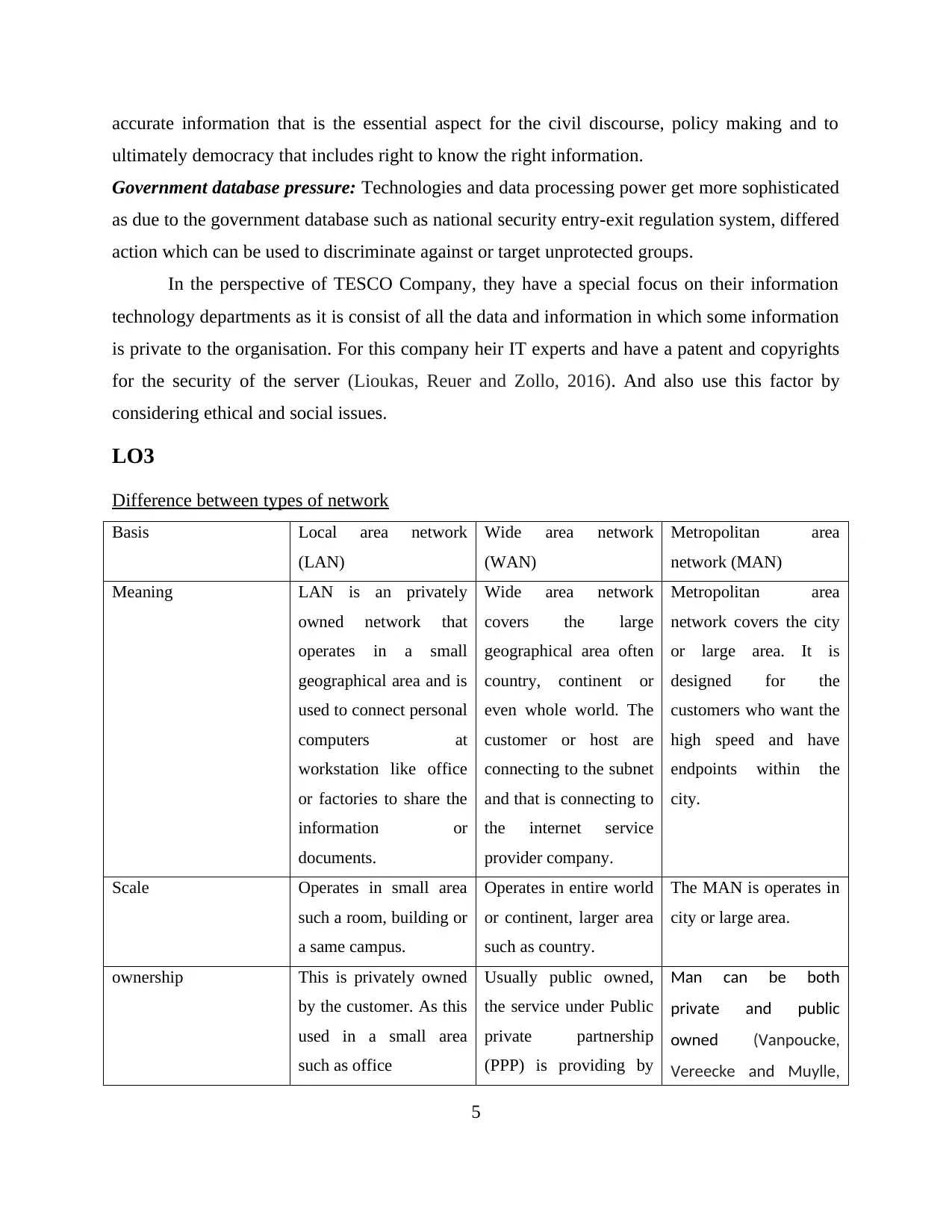
accurate information that is the essential aspect for the civil discourse, policy making and to
ultimately democracy that includes right to know the right information.
Government database pressure: Technologies and data processing power get more sophisticated
as due to the government database such as national security entry-exit regulation system, differed
action which can be used to discriminate against or target unprotected groups.
In the perspective of TESCO Company, they have a special focus on their information
technology departments as it is consist of all the data and information in which some information
is private to the organisation. For this company heir IT experts and have a patent and copyrights
for the security of the server (Lioukas, Reuer and Zollo, 2016). And also use this factor by
considering ethical and social issues.
LO3
Difference between types of network
Basis Local area network
(LAN)
Wide area network
(WAN)
Metropolitan area
network (MAN)
Meaning LAN is an privately
owned network that
operates in a small
geographical area and is
used to connect personal
computers at
workstation like office
or factories to share the
information or
documents.
Wide area network
covers the large
geographical area often
country, continent or
even whole world. The
customer or host are
connecting to the subnet
and that is connecting to
the internet service
provider company.
Metropolitan area
network covers the city
or large area. It is
designed for the
customers who want the
high speed and have
endpoints within the
city.
Scale Operates in small area
such a room, building or
a same campus.
Operates in entire world
or continent, larger area
such as country.
The MAN is operates in
city or large area.
ownership This is privately owned
by the customer. As this
used in a small area
such as office
Usually public owned,
the service under Public
private partnership
(PPP) is providing by
Man can be both
private and public
owned (Vanpoucke,
Vereecke and Muylle,
5
ultimately democracy that includes right to know the right information.
Government database pressure: Technologies and data processing power get more sophisticated
as due to the government database such as national security entry-exit regulation system, differed
action which can be used to discriminate against or target unprotected groups.
In the perspective of TESCO Company, they have a special focus on their information
technology departments as it is consist of all the data and information in which some information
is private to the organisation. For this company heir IT experts and have a patent and copyrights
for the security of the server (Lioukas, Reuer and Zollo, 2016). And also use this factor by
considering ethical and social issues.
LO3
Difference between types of network
Basis Local area network
(LAN)
Wide area network
(WAN)
Metropolitan area
network (MAN)
Meaning LAN is an privately
owned network that
operates in a small
geographical area and is
used to connect personal
computers at
workstation like office
or factories to share the
information or
documents.
Wide area network
covers the large
geographical area often
country, continent or
even whole world. The
customer or host are
connecting to the subnet
and that is connecting to
the internet service
provider company.
Metropolitan area
network covers the city
or large area. It is
designed for the
customers who want the
high speed and have
endpoints within the
city.
Scale Operates in small area
such a room, building or
a same campus.
Operates in entire world
or continent, larger area
such as country.
The MAN is operates in
city or large area.
ownership This is privately owned
by the customer. As this
used in a small area
such as office
Usually public owned,
the service under Public
private partnership
(PPP) is providing by
Man can be both
private and public
owned (Vanpoucke,
Vereecke and Muylle,
5
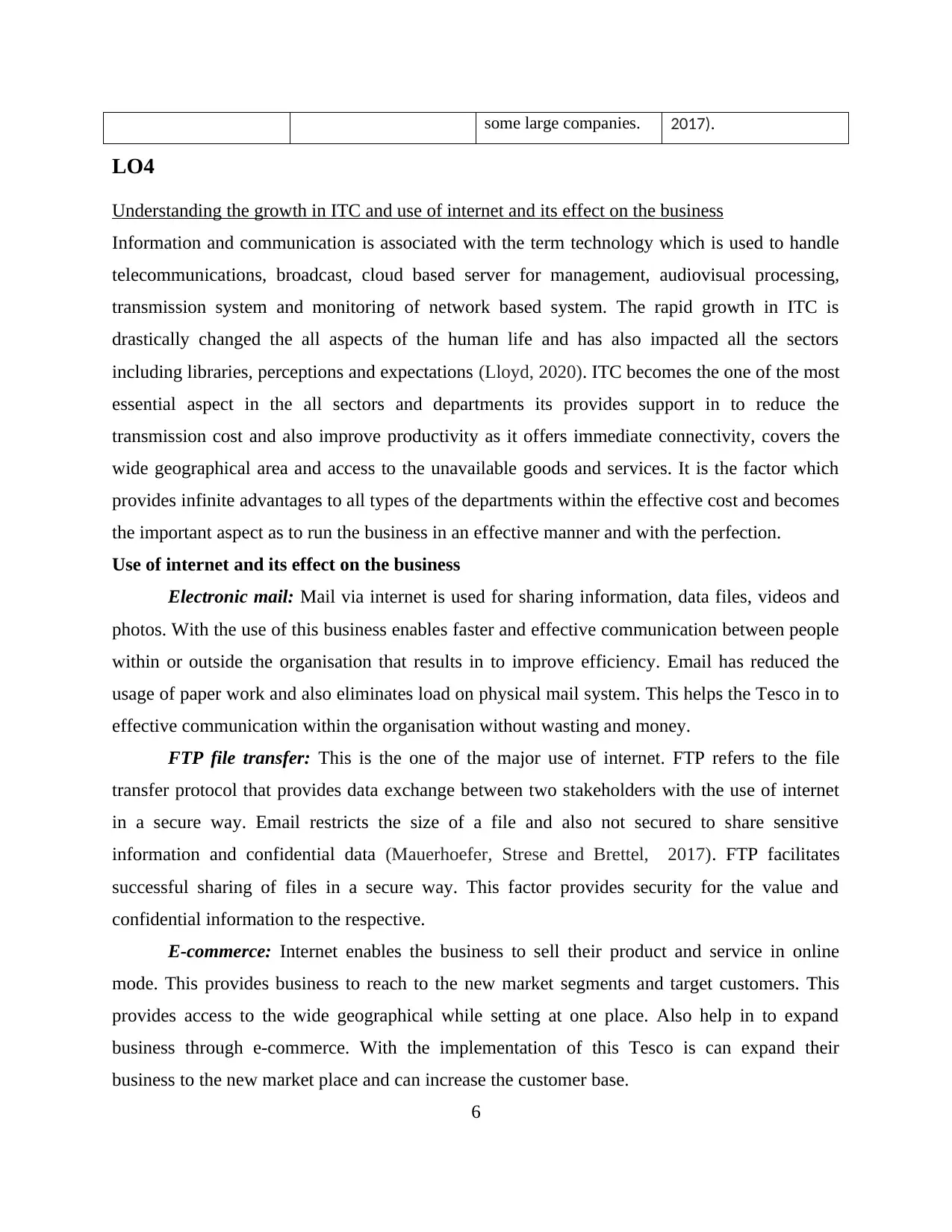
some large companies. 2017).
LO4
Understanding the growth in ITC and use of internet and its effect on the business
Information and communication is associated with the term technology which is used to handle
telecommunications, broadcast, cloud based server for management, audiovisual processing,
transmission system and monitoring of network based system. The rapid growth in ITC is
drastically changed the all aspects of the human life and has also impacted all the sectors
including libraries, perceptions and expectations (Lloyd, 2020). ITC becomes the one of the most
essential aspect in the all sectors and departments its provides support in to reduce the
transmission cost and also improve productivity as it offers immediate connectivity, covers the
wide geographical area and access to the unavailable goods and services. It is the factor which
provides infinite advantages to all types of the departments within the effective cost and becomes
the important aspect as to run the business in an effective manner and with the perfection.
Use of internet and its effect on the business
Electronic mail: Mail via internet is used for sharing information, data files, videos and
photos. With the use of this business enables faster and effective communication between people
within or outside the organisation that results in to improve efficiency. Email has reduced the
usage of paper work and also eliminates load on physical mail system. This helps the Tesco in to
effective communication within the organisation without wasting and money.
FTP file transfer: This is the one of the major use of internet. FTP refers to the file
transfer protocol that provides data exchange between two stakeholders with the use of internet
in a secure way. Email restricts the size of a file and also not secured to share sensitive
information and confidential data (Mauerhoefer, Strese and Brettel, 2017). FTP facilitates
successful sharing of files in a secure way. This factor provides security for the value and
confidential information to the respective.
E-commerce: Internet enables the business to sell their product and service in online
mode. This provides business to reach to the new market segments and target customers. This
provides access to the wide geographical while setting at one place. Also help in to expand
business through e-commerce. With the implementation of this Tesco is can expand their
business to the new market place and can increase the customer base.
6
LO4
Understanding the growth in ITC and use of internet and its effect on the business
Information and communication is associated with the term technology which is used to handle
telecommunications, broadcast, cloud based server for management, audiovisual processing,
transmission system and monitoring of network based system. The rapid growth in ITC is
drastically changed the all aspects of the human life and has also impacted all the sectors
including libraries, perceptions and expectations (Lloyd, 2020). ITC becomes the one of the most
essential aspect in the all sectors and departments its provides support in to reduce the
transmission cost and also improve productivity as it offers immediate connectivity, covers the
wide geographical area and access to the unavailable goods and services. It is the factor which
provides infinite advantages to all types of the departments within the effective cost and becomes
the important aspect as to run the business in an effective manner and with the perfection.
Use of internet and its effect on the business
Electronic mail: Mail via internet is used for sharing information, data files, videos and
photos. With the use of this business enables faster and effective communication between people
within or outside the organisation that results in to improve efficiency. Email has reduced the
usage of paper work and also eliminates load on physical mail system. This helps the Tesco in to
effective communication within the organisation without wasting and money.
FTP file transfer: This is the one of the major use of internet. FTP refers to the file
transfer protocol that provides data exchange between two stakeholders with the use of internet
in a secure way. Email restricts the size of a file and also not secured to share sensitive
information and confidential data (Mauerhoefer, Strese and Brettel, 2017). FTP facilitates
successful sharing of files in a secure way. This factor provides security for the value and
confidential information to the respective.
E-commerce: Internet enables the business to sell their product and service in online
mode. This provides business to reach to the new market segments and target customers. This
provides access to the wide geographical while setting at one place. Also help in to expand
business through e-commerce. With the implementation of this Tesco is can expand their
business to the new market place and can increase the customer base.
6
⊘ This is a preview!⊘
Do you want full access?
Subscribe today to unlock all pages.

Trusted by 1+ million students worldwide
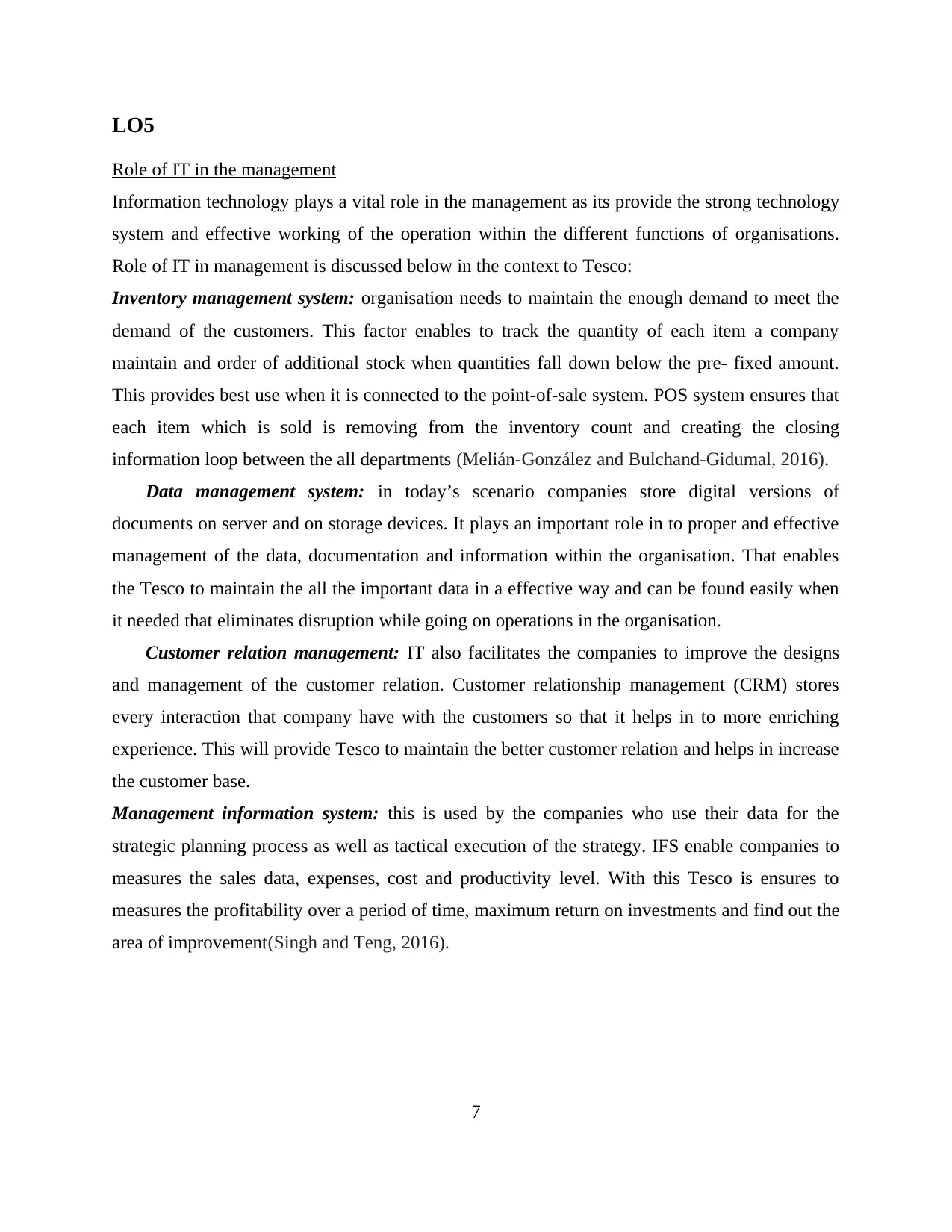
LO5
Role of IT in the management
Information technology plays a vital role in the management as its provide the strong technology
system and effective working of the operation within the different functions of organisations.
Role of IT in management is discussed below in the context to Tesco:
Inventory management system: organisation needs to maintain the enough demand to meet the
demand of the customers. This factor enables to track the quantity of each item a company
maintain and order of additional stock when quantities fall down below the pre- fixed amount.
This provides best use when it is connected to the point-of-sale system. POS system ensures that
each item which is sold is removing from the inventory count and creating the closing
information loop between the all departments (Melián-González and Bulchand-Gidumal, 2016).
Data management system: in today’s scenario companies store digital versions of
documents on server and on storage devices. It plays an important role in to proper and effective
management of the data, documentation and information within the organisation. That enables
the Tesco to maintain the all the important data in a effective way and can be found easily when
it needed that eliminates disruption while going on operations in the organisation.
Customer relation management: IT also facilitates the companies to improve the designs
and management of the customer relation. Customer relationship management (CRM) stores
every interaction that company have with the customers so that it helps in to more enriching
experience. This will provide Tesco to maintain the better customer relation and helps in increase
the customer base.
Management information system: this is used by the companies who use their data for the
strategic planning process as well as tactical execution of the strategy. IFS enable companies to
measures the sales data, expenses, cost and productivity level. With this Tesco is ensures to
measures the profitability over a period of time, maximum return on investments and find out the
area of improvement(Singh and Teng, 2016).
7
Role of IT in the management
Information technology plays a vital role in the management as its provide the strong technology
system and effective working of the operation within the different functions of organisations.
Role of IT in management is discussed below in the context to Tesco:
Inventory management system: organisation needs to maintain the enough demand to meet the
demand of the customers. This factor enables to track the quantity of each item a company
maintain and order of additional stock when quantities fall down below the pre- fixed amount.
This provides best use when it is connected to the point-of-sale system. POS system ensures that
each item which is sold is removing from the inventory count and creating the closing
information loop between the all departments (Melián-González and Bulchand-Gidumal, 2016).
Data management system: in today’s scenario companies store digital versions of
documents on server and on storage devices. It plays an important role in to proper and effective
management of the data, documentation and information within the organisation. That enables
the Tesco to maintain the all the important data in a effective way and can be found easily when
it needed that eliminates disruption while going on operations in the organisation.
Customer relation management: IT also facilitates the companies to improve the designs
and management of the customer relation. Customer relationship management (CRM) stores
every interaction that company have with the customers so that it helps in to more enriching
experience. This will provide Tesco to maintain the better customer relation and helps in increase
the customer base.
Management information system: this is used by the companies who use their data for the
strategic planning process as well as tactical execution of the strategy. IFS enable companies to
measures the sales data, expenses, cost and productivity level. With this Tesco is ensures to
measures the profitability over a period of time, maximum return on investments and find out the
area of improvement(Singh and Teng, 2016).
7
Paraphrase This Document
Need a fresh take? Get an instant paraphrase of this document with our AI Paraphraser
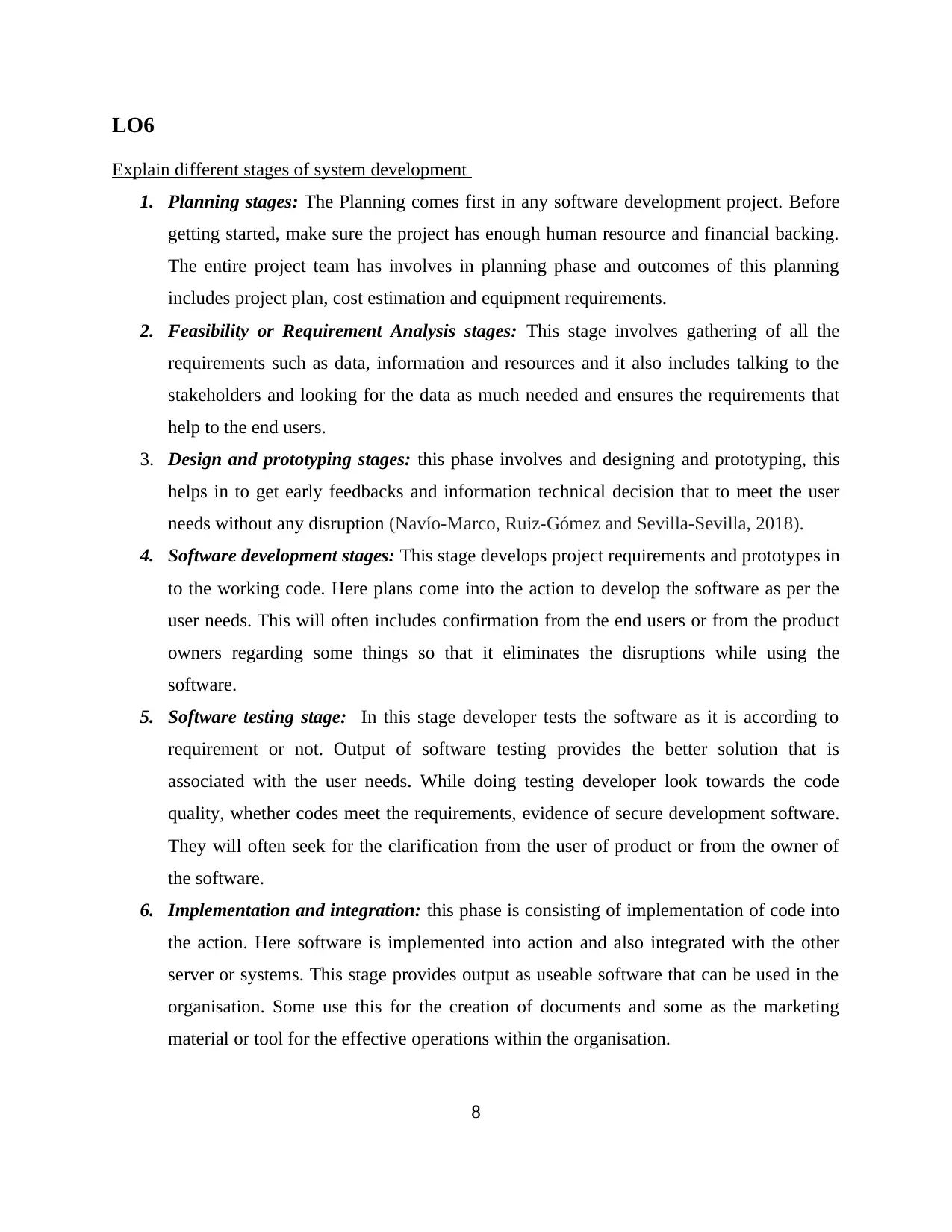
LO6
Explain different stages of system development
1. Planning stages: The Planning comes first in any software development project. Before
getting started, make sure the project has enough human resource and financial backing.
The entire project team has involves in planning phase and outcomes of this planning
includes project plan, cost estimation and equipment requirements.
2. Feasibility or Requirement Analysis stages: This stage involves gathering of all the
requirements such as data, information and resources and it also includes talking to the
stakeholders and looking for the data as much needed and ensures the requirements that
help to the end users.
3. Design and prototyping stages: this phase involves and designing and prototyping, this
helps in to get early feedbacks and information technical decision that to meet the user
needs without any disruption (Navío-Marco, Ruiz-Gómez and Sevilla-Sevilla, 2018).
4. Software development stages: This stage develops project requirements and prototypes in
to the working code. Here plans come into the action to develop the software as per the
user needs. This will often includes confirmation from the end users or from the product
owners regarding some things so that it eliminates the disruptions while using the
software.
5. Software testing stage: In this stage developer tests the software as it is according to
requirement or not. Output of software testing provides the better solution that is
associated with the user needs. While doing testing developer look towards the code
quality, whether codes meet the requirements, evidence of secure development software.
They will often seek for the clarification from the user of product or from the owner of
the software.
6. Implementation and integration: this phase is consisting of implementation of code into
the action. Here software is implemented into action and also integrated with the other
server or systems. This stage provides output as useable software that can be used in the
organisation. Some use this for the creation of documents and some as the marketing
material or tool for the effective operations within the organisation.
8
Explain different stages of system development
1. Planning stages: The Planning comes first in any software development project. Before
getting started, make sure the project has enough human resource and financial backing.
The entire project team has involves in planning phase and outcomes of this planning
includes project plan, cost estimation and equipment requirements.
2. Feasibility or Requirement Analysis stages: This stage involves gathering of all the
requirements such as data, information and resources and it also includes talking to the
stakeholders and looking for the data as much needed and ensures the requirements that
help to the end users.
3. Design and prototyping stages: this phase involves and designing and prototyping, this
helps in to get early feedbacks and information technical decision that to meet the user
needs without any disruption (Navío-Marco, Ruiz-Gómez and Sevilla-Sevilla, 2018).
4. Software development stages: This stage develops project requirements and prototypes in
to the working code. Here plans come into the action to develop the software as per the
user needs. This will often includes confirmation from the end users or from the product
owners regarding some things so that it eliminates the disruptions while using the
software.
5. Software testing stage: In this stage developer tests the software as it is according to
requirement or not. Output of software testing provides the better solution that is
associated with the user needs. While doing testing developer look towards the code
quality, whether codes meet the requirements, evidence of secure development software.
They will often seek for the clarification from the user of product or from the owner of
the software.
6. Implementation and integration: this phase is consisting of implementation of code into
the action. Here software is implemented into action and also integrated with the other
server or systems. This stage provides output as useable software that can be used in the
organisation. Some use this for the creation of documents and some as the marketing
material or tool for the effective operations within the organisation.
8
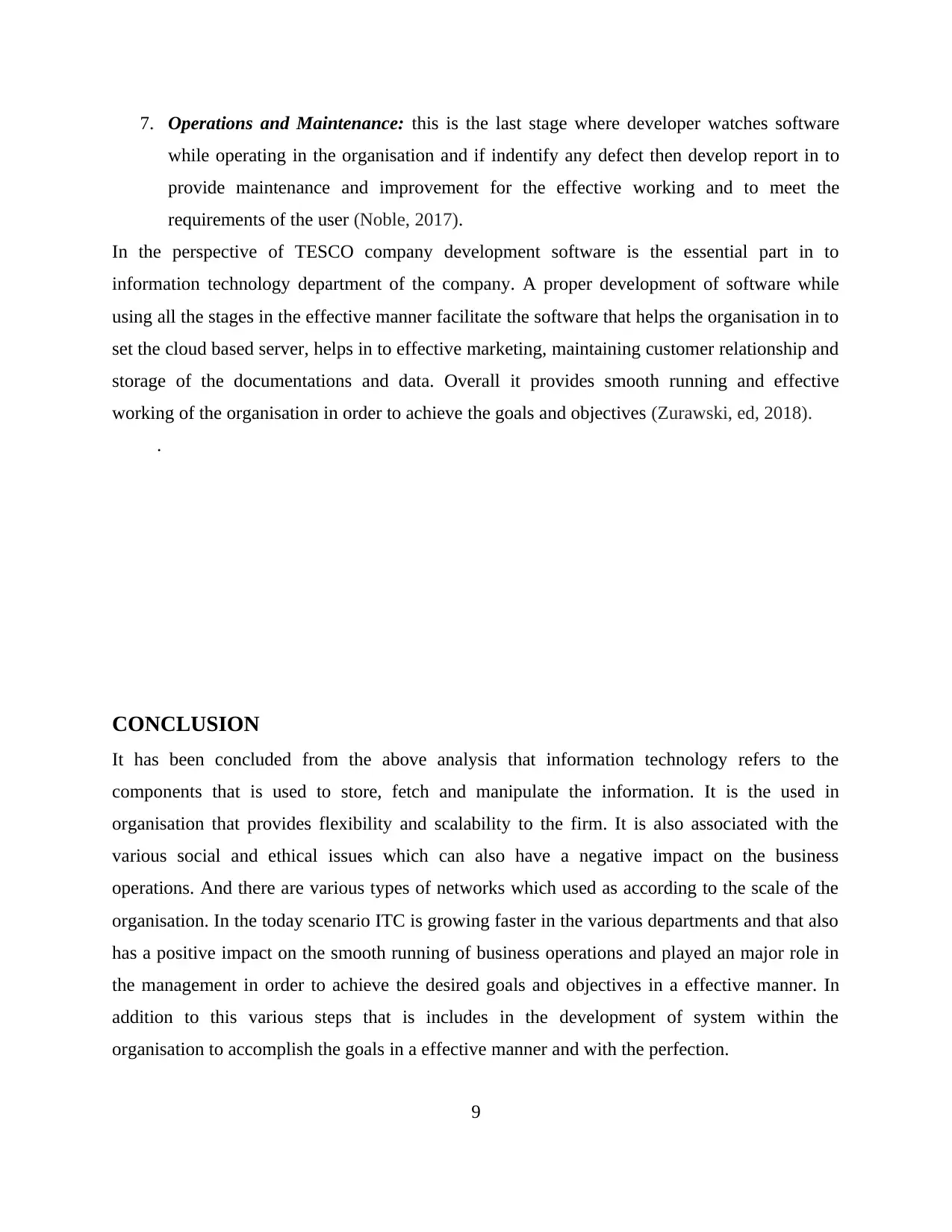
7. Operations and Maintenance: this is the last stage where developer watches software
while operating in the organisation and if indentify any defect then develop report in to
provide maintenance and improvement for the effective working and to meet the
requirements of the user (Noble, 2017).
In the perspective of TESCO company development software is the essential part in to
information technology department of the company. A proper development of software while
using all the stages in the effective manner facilitate the software that helps the organisation in to
set the cloud based server, helps in to effective marketing, maintaining customer relationship and
storage of the documentations and data. Overall it provides smooth running and effective
working of the organisation in order to achieve the goals and objectives (Zurawski, ed, 2018).
.
CONCLUSION
It has been concluded from the above analysis that information technology refers to the
components that is used to store, fetch and manipulate the information. It is the used in
organisation that provides flexibility and scalability to the firm. It is also associated with the
various social and ethical issues which can also have a negative impact on the business
operations. And there are various types of networks which used as according to the scale of the
organisation. In the today scenario ITC is growing faster in the various departments and that also
has a positive impact on the smooth running of business operations and played an major role in
the management in order to achieve the desired goals and objectives in a effective manner. In
addition to this various steps that is includes in the development of system within the
organisation to accomplish the goals in a effective manner and with the perfection.
9
while operating in the organisation and if indentify any defect then develop report in to
provide maintenance and improvement for the effective working and to meet the
requirements of the user (Noble, 2017).
In the perspective of TESCO company development software is the essential part in to
information technology department of the company. A proper development of software while
using all the stages in the effective manner facilitate the software that helps the organisation in to
set the cloud based server, helps in to effective marketing, maintaining customer relationship and
storage of the documentations and data. Overall it provides smooth running and effective
working of the organisation in order to achieve the goals and objectives (Zurawski, ed, 2018).
.
CONCLUSION
It has been concluded from the above analysis that information technology refers to the
components that is used to store, fetch and manipulate the information. It is the used in
organisation that provides flexibility and scalability to the firm. It is also associated with the
various social and ethical issues which can also have a negative impact on the business
operations. And there are various types of networks which used as according to the scale of the
organisation. In the today scenario ITC is growing faster in the various departments and that also
has a positive impact on the smooth running of business operations and played an major role in
the management in order to achieve the desired goals and objectives in a effective manner. In
addition to this various steps that is includes in the development of system within the
organisation to accomplish the goals in a effective manner and with the perfection.
9
⊘ This is a preview!⊘
Do you want full access?
Subscribe today to unlock all pages.

Trusted by 1+ million students worldwide
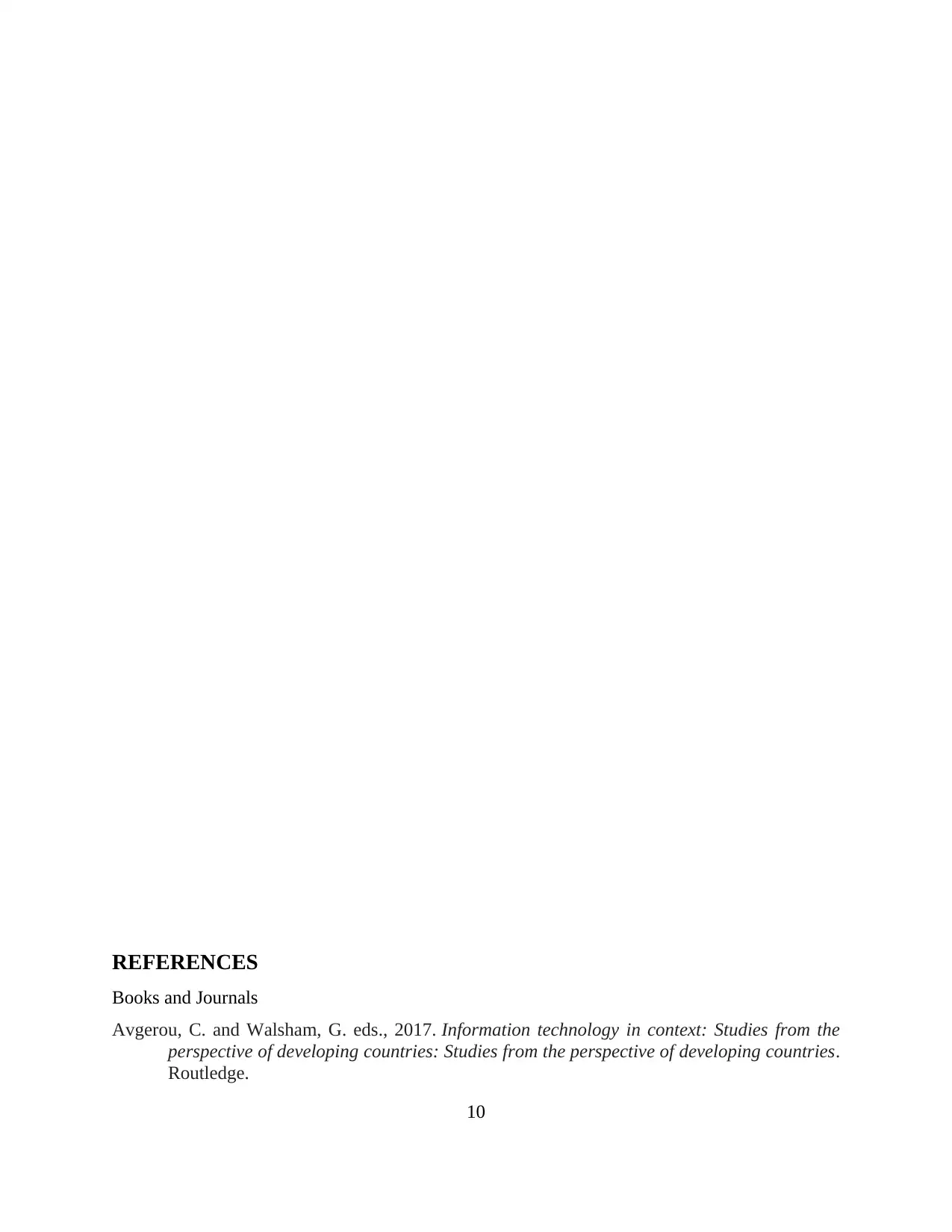
REFERENCES
Books and Journals
Avgerou, C. and Walsham, G. eds., 2017. Information technology in context: Studies from the
perspective of developing countries: Studies from the perspective of developing countries.
Routledge.
10
Books and Journals
Avgerou, C. and Walsham, G. eds., 2017. Information technology in context: Studies from the
perspective of developing countries: Studies from the perspective of developing countries.
Routledge.
10
Paraphrase This Document
Need a fresh take? Get an instant paraphrase of this document with our AI Paraphraser
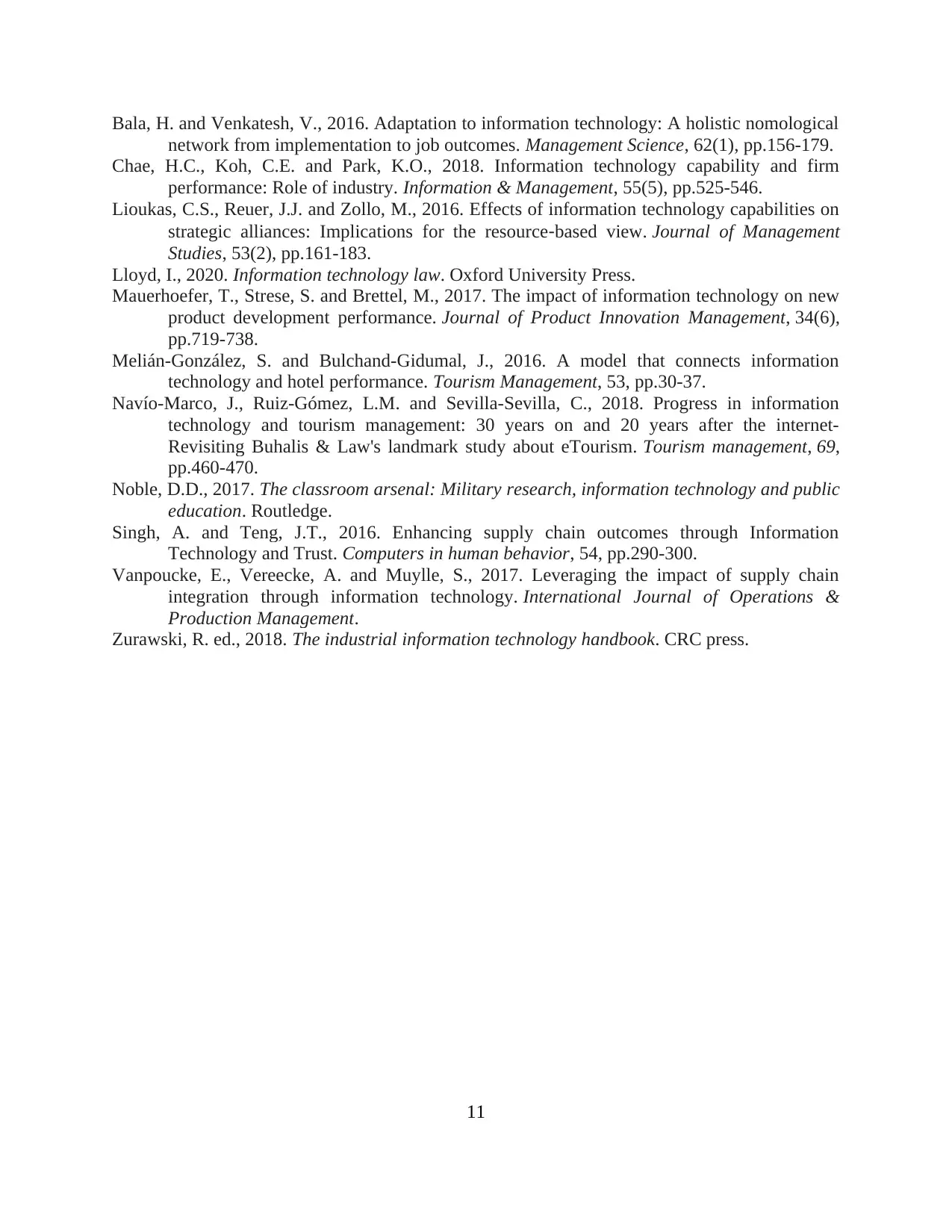
Bala, H. and Venkatesh, V., 2016. Adaptation to information technology: A holistic nomological
network from implementation to job outcomes. Management Science, 62(1), pp.156-179.
Chae, H.C., Koh, C.E. and Park, K.O., 2018. Information technology capability and firm
performance: Role of industry. Information & Management, 55(5), pp.525-546.
Lioukas, C.S., Reuer, J.J. and Zollo, M., 2016. Effects of information technology capabilities on
strategic alliances: Implications for the resource‐based view. Journal of Management
Studies, 53(2), pp.161-183.
Lloyd, I., 2020. Information technology law. Oxford University Press.
Mauerhoefer, T., Strese, S. and Brettel, M., 2017. The impact of information technology on new
product development performance. Journal of Product Innovation Management, 34(6),
pp.719-738.
Melián-González, S. and Bulchand-Gidumal, J., 2016. A model that connects information
technology and hotel performance. Tourism Management, 53, pp.30-37.
Navío-Marco, J., Ruiz-Gómez, L.M. and Sevilla-Sevilla, C., 2018. Progress in information
technology and tourism management: 30 years on and 20 years after the internet-
Revisiting Buhalis & Law's landmark study about eTourism. Tourism management, 69,
pp.460-470.
Noble, D.D., 2017. The classroom arsenal: Military research, information technology and public
education. Routledge.
Singh, A. and Teng, J.T., 2016. Enhancing supply chain outcomes through Information
Technology and Trust. Computers in human behavior, 54, pp.290-300.
Vanpoucke, E., Vereecke, A. and Muylle, S., 2017. Leveraging the impact of supply chain
integration through information technology. International Journal of Operations &
Production Management.
Zurawski, R. ed., 2018. The industrial information technology handbook. CRC press.
11
network from implementation to job outcomes. Management Science, 62(1), pp.156-179.
Chae, H.C., Koh, C.E. and Park, K.O., 2018. Information technology capability and firm
performance: Role of industry. Information & Management, 55(5), pp.525-546.
Lioukas, C.S., Reuer, J.J. and Zollo, M., 2016. Effects of information technology capabilities on
strategic alliances: Implications for the resource‐based view. Journal of Management
Studies, 53(2), pp.161-183.
Lloyd, I., 2020. Information technology law. Oxford University Press.
Mauerhoefer, T., Strese, S. and Brettel, M., 2017. The impact of information technology on new
product development performance. Journal of Product Innovation Management, 34(6),
pp.719-738.
Melián-González, S. and Bulchand-Gidumal, J., 2016. A model that connects information
technology and hotel performance. Tourism Management, 53, pp.30-37.
Navío-Marco, J., Ruiz-Gómez, L.M. and Sevilla-Sevilla, C., 2018. Progress in information
technology and tourism management: 30 years on and 20 years after the internet-
Revisiting Buhalis & Law's landmark study about eTourism. Tourism management, 69,
pp.460-470.
Noble, D.D., 2017. The classroom arsenal: Military research, information technology and public
education. Routledge.
Singh, A. and Teng, J.T., 2016. Enhancing supply chain outcomes through Information
Technology and Trust. Computers in human behavior, 54, pp.290-300.
Vanpoucke, E., Vereecke, A. and Muylle, S., 2017. Leveraging the impact of supply chain
integration through information technology. International Journal of Operations &
Production Management.
Zurawski, R. ed., 2018. The industrial information technology handbook. CRC press.
11
1 out of 11
Related Documents
Your All-in-One AI-Powered Toolkit for Academic Success.
+13062052269
info@desklib.com
Available 24*7 on WhatsApp / Email
![[object Object]](/_next/static/media/star-bottom.7253800d.svg)
Unlock your academic potential
Copyright © 2020–2025 A2Z Services. All Rights Reserved. Developed and managed by ZUCOL.




